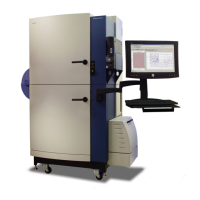0112-0109 H 273
B
Data Processing Algorithms
This appendix uses results of a hypothetical experiment to describe the
algorithms that can be used to adjust data. These options are all
applied from the Correction dialog.
Hypothetical Experiment
Consider the results from an experiment consisting of wells A1–A9. The
wells are classified into three groups:
• A1–A3: Negative Control Wells (–Ctrl). These wells contain the
same dye-loaded cells and buffers as the other wells, yet are not
exposed to a stimulus.
• A4–A6: Experimental Wells (Exp). These cells receive the
experimental stimulus.
• A7–A9: Positive Control Wells. (+Ctrl). These cells either (1)
receive a stimulus known to elicit a predetermined response or
(2) demonstrate the maximal activity from an agonist.
In the following experiment, six samples (also known as pictures,
readings, or frames) were taken at five-second intervals. After Sample
3 was taken, buffer (with or without stimulus) was added to the wells.
The data presented is in the same format as the export data files
generated using the FLIPR
®
Tetra System software. (In this example,
only nine wells are considered.)
Note: The longer time between readings 3 and 4. This time includes
the time necessary for the 96-well pipettor to transfer liquids from the
source plate to the cell plate and is automatically corrected for by the
FLIPR
®
Tetra
System.

